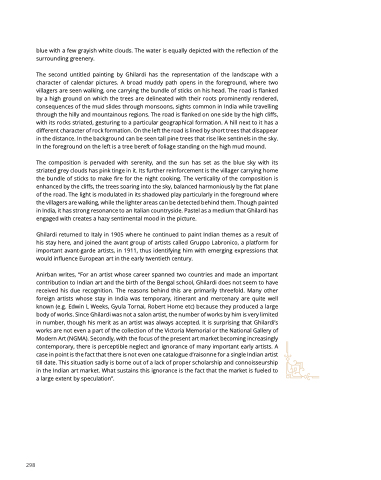Page 304 - Eye of the beholder
P. 304
blue with a few grayish white clouds. The water is equally depicted with the reflection of the surrounding greenery.
The second untitled painting by Ghilardi has the representation of the landscape with a character of calendar pictures. A broad muddy path opens in the foreground, where two villagers are seen walking, one carrying the bundle of sticks on his head. The road is flanked by a high ground on which the trees are delineated with their roots prominently rendered, consequences of the mud slides through monsoons, sights common in India while travelling through the hilly and mountainous regions. The road is flanked on one side by the high cliffs, with its rocks striated, gesturing to a particular geographical formation. A hill next to it has a different character of rock formation. On the left the road is lined by short trees that disappear in the distance. In the background can be seen tall pine trees that rise like sentinels in the sky. In the foreground on the left is a tree bereft of foliage standing on the high mud mound.
The composition is pervaded with serenity, and the sun has set as the blue sky with its striated grey clouds has pink tinge in it. Its further reinforcement is the villager carrying home the bundle of sticks to make fire for the night cooking. The verticality of the composition is enhanced by the cliffs, the trees soaring into the sky, balanced harmoniously by the flat plane of the road. The light is modulated in its shadowed play particularly in the foreground where the villagers are walking, while the lighter areas can be detected behind them. Though painted in India, it has strong resonance to an Italian countryside. Pastel as a medium that Ghilardi has engaged with creates a hazy sentimental mood in the picture.
Ghilardi returned to Italy in 1905 where he continued to paint Indian themes as a result of his stay here, and joined the avant group of artists called Gruppo Labronico, a platform for important avant-garde artists, in 1911, thus identifying him with emerging expressions that would influence European art in the early twentieth century.
Anirban writes, “For an artist whose career spanned two countries and made an important contribution to Indian art and the birth of the Bengal school, Ghilardi does not seem to have received his due recognition. The reasons behind this are primarily threefold. Many other foreign artists whose stay in India was temporary, itinerant and mercenary are quite well known (e.g. Edwin L Weeks, Gyula Tornai, Robert Home etc) because they produced a large body of works. Since Ghilardi was not a salon artist, the number of works by him is very limited in number, though his merit as an artist was always accepted. It is surprising that Ghilardi’s works are not even a part of the collection of the Victoria Memorial or the National Gallery of Modern Art (NGMA). Secondly, with the focus of the present art market becoming increasingly contemporary, there is perceptible neglect and ignorance of many important early artists. A case in point is the fact that there is not even one catalogue d’raisonne for a single Indian artist till date. This situation sadly is borne out of a lack of proper scholarship and connoisseurship in the Indian art market. What sustains this ignorance is the fact that the market is fueled to a large extent by speculation”.
298


